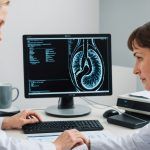Overview of UK Guidelines on Fetal Spinal Abnormality Screening
The UK fetal spinal abnormality guidelines have developed significantly over the years, shaped by evolving research and technological advancements. Initially, these guidelines primarily focused on basic fetal screening procedures, but they have progressively integrated more comprehensive and precise methods. The refinement of these guidelines underscores the critical importance of early detection and management of fetal spinal abnormalities. Timely identification of these conditions can significantly improve prenatal care options and outcomes.
Evolution of Screening Guidelines
The evolution of guidelines reflects the growing understanding of prenatal care and the potential complications associated with fetal spinal abnormalities. As more was understood about these disorders, screening methods became more robust, aiming to minimise risks to the fetus.
This might interest you : Ultimate travel tips for expecting mothers: navigating uk airlines” air travel regulations
Importance and Processes of Screening
Screening for fetal spinal abnormalities involves a series of recommended procedures. The guidelines emphasise the use of efficient and reliable fetal screening procedures to ensure accurate assessments. This includes advanced sonographic techniques and detailed diagnostic imaging that form a comprehensive framework for effective prenatal evaluation. Such thorough resources support healthcare professionals in making informed decisions, which are vital for managing prenatal care effectively.
Understanding Fetal Spinal Abnormalities
Fetal spinal abnormalities encompass a range of defects that significantly affect fetal development, potentially leading to severe complications. These abnormalities are classified into different types, including spina bifida and other neural tube defects. Spina bifida, one of the most prevalent conditions, occurs when the spinal cord and its surrounding structures do not form correctly.
This might interest you : Vital dietary recommendations for expecting mothers in the uk aged 40+: addressing unique health requirements
Understanding these conditions is crucial because untreated spinal abnormalities can profoundly impact the physical health and quality of life of the affected individual. For instance, the implications of untreated defects might range from physical disabilities to challenges in cognitive development, depending on the severity and location of the defect.
The prevalence of spinal defects varies, but certain risk factors are consistently associated. These include genetic predispositions, dietary deficiencies during pregnancy, particularly folic acid, and environmental factors. By recognising these factors, healthcare providers can offer tailored advice and support to at-risk populations, enhancing prenatal care outcomes.
Overall, a thorough comprehension of fetal spinal abnormalities allows for proactive management strategies, ensuring optimal fetal health and development.
Screening Processes and Techniques
Sonographic screening and diagnostic imaging techniques form the core of prenatal diagnostic tools for detecting fetal spinal abnormalities. These methods are integral to assessing and monitoring fetal development, enabling timely intervention. Ultrasound is the primary tool, widely acclaimed for its non-invasive nature and accuracy in visualising fetal structures. Utilising advanced sonographic methods increases the precision in identifying potential defects.
Additionally, Magnetic Resonance Imaging (MRI) plays a substantial role when more detailed imaging is required, typically following initial abnormal findings on ultrasound. This technique provides intricate insights into the fetal spine and surrounding areas, assisting in comprehensive evaluations.
Guidelines recommend strategic timing and frequency for these screenings to ensure effective monitoring of fetal development. Initial screenings generally occur in the first trimester, with follow-up imaging guided by clinical assessments and developmental markers. Standard procedures suggest periodic evaluations throughout pregnancy to track any abnormalities’ progress.
Collectively, these prenatal diagnostic tools ensure robust detection processes. They allow healthcare providers to adopt appropriate management plans, ensuring optimal outcomes for both mother and fetus. Understanding the capabilities and limitations of these screening methods is essential for the accurate interpretation of results and subsequent clinical decision-making.
Interpretation of Results
Accurately interpreting screening results is pivotal for effective fetal diagnosis and clinical decision-making. When anomalies are detected, healthcare providers must carefully analyse these outcomes to determine the next steps. Challenges in diagnosing spinal abnormalities arise due to the potential for false positives or ambiguities in imaging results. Therefore, a nuanced understanding of the variations in fetal development is critical.
Healthcare professionals utilize a combination of initial findings and follow-up evaluations to arrive at a conclusive diagnosis. It’s crucial to consider the relevant follow-up procedures based on results that may include more refined imaging or consultations with specialists. These steps are integral to confirming the presence and severity of spinal defects.
Moreover, engaging with families compassionately while conveying results is essential. Clarity in explaining both findings and potential interventions can alleviate parental anxiety. This approach ensures informed decision-making by parents who may face complex choices regarding their pregnancy. Regular training and updates on fetal diagnosis for practitioners play a significant role in maintaining reliable interpretation standards and improving prenatal care outcomes, bolstering confidence in following recommended screening results interpretation practices.
Recommended Practices for Healthcare Professionals
In the context of diagnosing fetal spinal abnormalities, adhering to established guidelines is crucial. Healthcare professionals should integrate key clinical practices into routine screening to enhance efficacy. A notable recommendation is adopting an interdisciplinary approach: involving obstetricians, radiologists, and genetic counsellors ensures a holistic examination and management plan.
Communication with expectant parents is another pivotal concern. Ethical considerations dictate that practitioners deliver information compassionately and transparently, fostering trust. Providing clear explanations of test outcomes, coupled with supportive resources, aids parents in navigating complex scenarios with confidence and clarity.
Professionals must also balance their commitment to precision in diagnosis with ethical responsibilities, ensuring they act in the best interests of patient wellbeing. Continuing education and regular training updates are vital, enhancing practitioners’ capabilities to interpret advancements in diagnostic imaging techniques and their implications on prenatal care.
Emphasising a comprehensive care model, which includes patient education and tailored decision-making processes, can improve outcomes. By using guidelines for practitioners effectively, healthcare providers contribute significantly to enhanced prenatal care experiences, meeting both medical and emotional needs of the families they serve.
Case Studies and Expert Opinions
In examining the application of UK fetal spinal abnormality guidelines, real-life case studies and expert insights provide valuable perspectives. These cases illustrate how guidelines translate into practice, offering a nuanced understanding of screening and management strategies.
One pivotal case involved the detection of spina bifida in the second trimester, emphasising the role of diagnostic imaging techniques. Expert opinions highlight the importance of using advanced sonographic screening to improve detection rates and precision. Such insights underscore the necessity of adapting screening protocols to include thorough prenatal diagnostic tools for identifying potential abnormalities.
An interdisciplinary approach, involving obstetricians, radiologists, and clinical practices, proved critical in offering comprehensive care. Experts advise that this multi-faceted strategy ensures holistic evaluations, optimising outcomes for both mother and fetus. Furthermore, lessons learned from these cases stress the significance of clear, empathetic communication with expectant parents, guiding them through the complexities of their situation.
These expert-informed practices not only enhance fetal screening procedures but also bolster clinician confidence in making informed clinical decision-making. Collectively, expert insights and case studies reaffirm the guidelines’ efficacy, underscoring their vital role in improving prenatal care outcomes.
Impact on Prenatal Care
Prenatal care implications are significant when it comes to screening for fetal spinal abnormalities, as these processes form the foundation of effective management strategies. Early detection through meticulous fetal screening procedures allows healthcare providers to establish tailored care plans, enhancing overall prenatal care outcomes. By addressing potential issues early, healthcare professionals are better equipped to handle any complications that might arise.
Support frameworks for parents receiving abnormal results play a crucial role. When unexpected findings occur, providing robust patient support becomes essential. This support often includes psychological counseling and connecting families with relevant resources or specialists. Clear communication further empowers parents to make informed decisions regarding their pregnancies, contributing to better care experiences.
Patient education is indispensable in these scenarios. It ensures parents understand the implications of their screening results and the subsequent steps. Through comprehensive educational resources, parents are equipped to engage fully with their care plans, fostering confidence and involvement in decision-making. This proactive approach aims to mitigate anxiety and promote healthy outcomes, underscoring the vital intersection between advanced screening and well-rounded prenatal care strategies.











